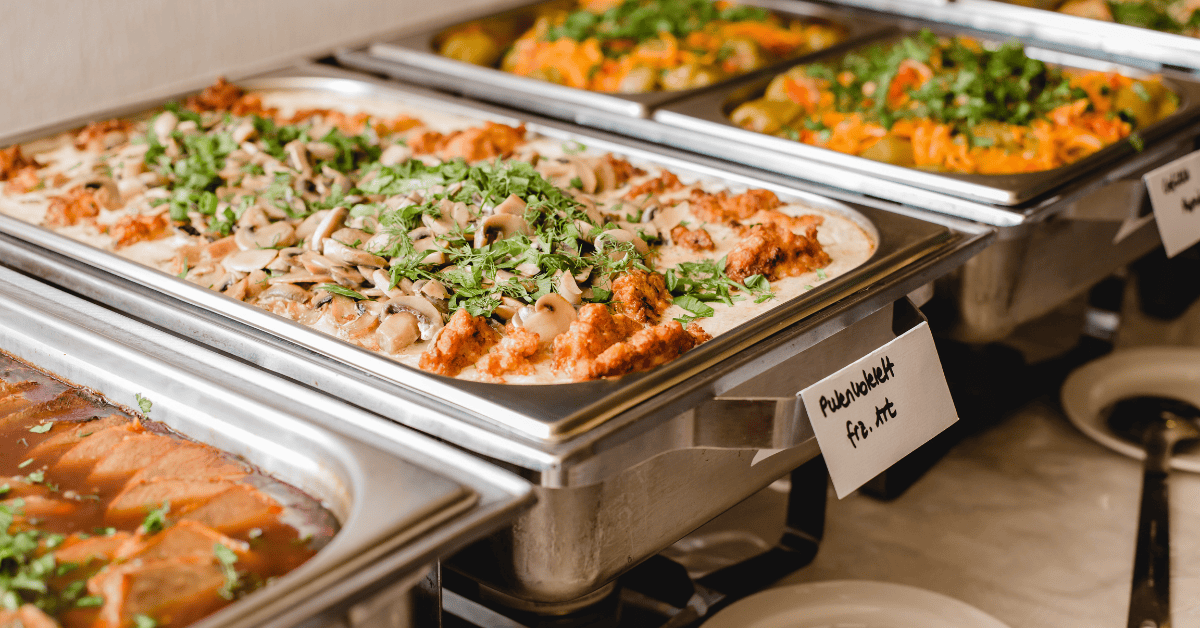In today’s diverse landscape of dietary preferences and medical needs, overlooking food safety can lead to serious consequences, from allergic reactions to cross-contamination risks that compromise guest well-being. A well-thought-out approach to food planning ensures compliance with health and safety standards and demonstrates a commitment to inclusivity and care.
By proactively addressing food safety concerns, you foster an environment where all attendees can focus on the event itself rather than worry about what’s on their plate. Thoughtful planning and clear communication with caterers and guests can make all the difference in transforming a simple meal into an experience that enhances engagement, satisfaction, and overall event success.
As a meeting planner, you hold a key responsibility in creating a dining experience that is both enjoyable and safe for all attendees. Here’s how you can meet (and exceed) expectations when it comes to food safety at your events.
Understanding Food Allergies and Dietary Restrictions
Food allergies are a serious concern, with some reactions being life-threatening. For some attendees, even a trace amount of an allergen can trigger a severe reaction. The most common culprits include peanuts, tree nuts, shellfish, dairy, gluten, soy, eggs, and sesame.
Beyond allergies, dietary needs can extend to lifestyle choices such as vegetarianism, veganism, and religious-based dietary laws. As a meeting planner, you play a vital role in making sure all attendees feel comfortable and cared for when it comes to food options.
A little extra effort in planning can go a long way in creating an inclusive and enjoyable dining experience. Here are some key steps to ensure every guest is accommodated:
1. Collect Attendee Dietary Preferences in Advance
It’s helpful to include a section in your registration form to capture dietary needs and make it mandatory to ensure all attendees provide the necessary details. Ask for specifics regarding allergies, intolerances, and dietary preferences to avoid ambiguity. It’s also a good idea to follow up with attendees closer to the event as this can help ensure the most up-to-date information is accounted for.
2. Confirm Allergen Handling Procedures with Caterers
Work closely with the event venue or catering team to ensure they have strict protocols in place for food preparation, storage, and serving to prevent cross-contamination. Discuss separate prep areas for allergen-free meals, how dishes will be plated and served, and what precautions are in place to avoid accidental exposure.
3. Train On-Site Staff on Allergy Awareness
Make sure the catering staff, servers, and event team are educated on the severity of food allergies, how to identify symptoms of allergic reactions, and the steps to take in an emergency. Providing clear guidance on handling guest concerns and ensuring all team members know where to find emergency response materials such as EpiPens or first-aid kits is crucial.
4. Provide Alternative Meal Options
Instead of offering a single alternative meal, try providing a variety of safe and inclusive menu options that ensure all guests have an enjoyable dining experience. Consider offering allergen-free choices that do not feel like a compromise, such as flavorful gluten-free, nut-free, and dairy-free dishes that appeal to all attendees. When possible, work with chefs to develop meals that seamlessly integrate dietary accommodations without sacrificing taste or presentation.
Collaborating with Hotel and Event Staff for Food Safety

Working closely with venue teams and catering staff is essential to creating a dining experience that is both safe and enjoyable. Clear communication and strong coordination help ensure that every meal served meets high food safety standards, giving you peace of mind and your attendees a worry-free experience.
Below are some helpful tips to use when working with venue staff:
Discuss Food Safety Protocols in Detail
Before finalizing the menu, have a meeting with the catering and venue team to go over food safety policies, allergen management, and emergency response procedures.
Request a Dedicated Point of Contact
Having a designated catering manager or chef available throughout the event ensures that last-minute questions or concerns can be addressed promptly.
Conduct a Walkthrough of the Catering Setup
Inspect the food preparation and serving areas to confirm that allergens are kept separate and that hygiene practices are being followed.
The most common food allergens include peanuts, tree nuts, shellfish, dairy, gluten, soy, eggs, and sesame–even a trace amount can trigger a severe reaction.
Ensure Emergency Measures Are in Place
Work with staff to identify where medical aid is located, ensure EpiPens are accessible if needed, and establish a protocol for handling severe allergic reactions.
Be prepared for any scenario–read this article for more tips on how to build a safe environment for your attendees.
Labeling and Transparency: Making Food Information Clear

A simple yet powerful way to improve food safety is by making sure every dish is clearly labeled. No guest should have to second-guess whether a meal is safe for them. Thoughtful, well-marked labels take the guesswork out of dining and help prevent allergic reactions, making the experience smoother and safer for everyone.
Best practices for labeling:
Use Detailed and Legible Signage
Labels should include key ingredients, allergen warnings, and potential cross-contamination risks. Make sure the font is large enough to be read easily, and avoid overly complex designs that might obscure the information. Consider using symbols for common allergens to make labels even more accessible to attendees who speak different languages.
Color-Code Food Stations
Designating different sections or trays for common allergens helps attendees make informed choices at a glance. For example, using a red label for “contains nuts,” a green label for “gluten-free,” and a blue label for “dairy-free” can reduce confusion and minimize the risk of accidental exposure. Clearly marking serving utensils and plates that correspond with each dietary category can further help prevent cross-contact.
Beyond allergies, dietary needs can extend to lifestyle choices such as vegetarianism, veganism, and religious-based dietary laws.
Provide Ingredient Lists and Digital Access
Offering printed ingredient lists at buffet stations or meal service tables is helpful, but digital options can take accessibility a step further. QR codes that link to detailed ingredient breakdowns, including potential cross-contamination warnings, allow guests to double-check their meal selections conveniently. This approach also reduces paper waste and provides real-time updates if menu items change.
Creating an Inclusive and Enjoyable Dining Experience

Accommodating dietary restrictions should never feel like an afterthought. Aim to create an inclusive environment where all attendees feel valued and included in the dining experience.
Design a Diverse and Flavorful Menu
Work with chefs to ensure allergen-free meals are just as delicious and appealing as the main menu. Consider offering a mix of classic favorites and creative dishes that cater to all dietary needs without making restricted meals feel different or inferior.
Offer Interactive Dining Options
Build-your-own stations, customizable meals, or self-serve buffets with clear signage allow attendees to make safe food choices. Consider ingredient substitution options that empower guests to personalize their meals based on their dietary needs.
Create Allergen-Free Dining Sections
Having designated tables or food stations for allergen-free meals reduces the risk of cross-contamination. Ensure these areas are clearly marked and easily accessible so guests feel comfortable choosing these options.
Provide Safe and Nutritious Snacks
Ensure that all event spaces, from breakout rooms to networking lounges, offer allergy-friendly snack options. Stock a variety of grab-and-go items such as pre-packaged nut-free protein bars, gluten-free crackers, and dairy-free yogurt alternatives to cater to different dietary needs throughout the day.
Hydration and Sanitation: Going Beyond the Plate
Food safety isn’t just about what’s on the plate—it also means keeping guests hydrated and maintaining a clean environment throughout the event. Making sure attendees feel comfortable while minimizing the spread of germs is essential for a smooth and successful gathering.
Essential tips for a safe and healthy environment:
- Provide Ample Water Stations: Dehydration can lead to fatigue and discomfort, so ensure water is readily available with clearly labeled, touch-free dispensers or reusable bottle stations.
- Ensure Hand Sanitizing Stations Are Accessible: Place sanitizing stations at food service areas, restrooms, and high-traffic locations to reduce germ transmission.
- Encourage Attendees to Practice Good Hygiene: Include reminders in event materials about handwashing and food safety to reinforce best practices.
-
Final Thoughts: Setting the Standard for Safe and Inclusive Events
As a meeting planner, your role in food safety is critical. By prioritizing clear communication with vendors, ensuring accurate food labeling, and fostering an inclusive dining experience, you can create an event that is both safe and memorable for all attendees. Going above and beyond with thoughtful planning, allergen-friendly meal options, and proper sanitation measures will not only enhance the overall experience but also reinforce your reputation as a detail-oriented and attendee-focused planner.
Incorporating these strategies into your event planning process will help you build trust with attendees, ensuring that they feel safe, included, and well cared for—because when it comes to food safety, a little extra effort goes a long way!
Upgrade your event planning strategy with GroupSync™ and see how easy group hotel reservations can be.
Ready for a more efficient way to book groups?
Reserve hotel rooms, meeting space, food & beverage and A/V all in a single transaction.


